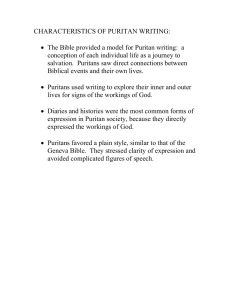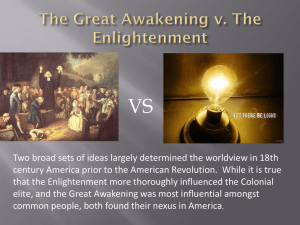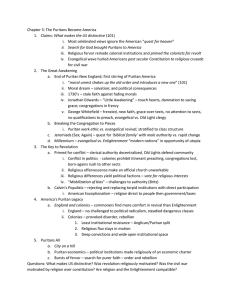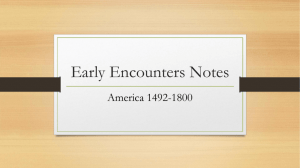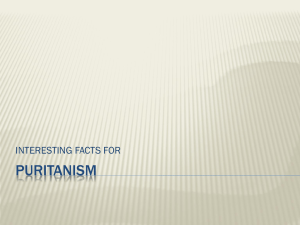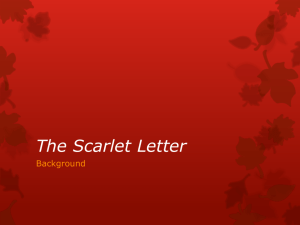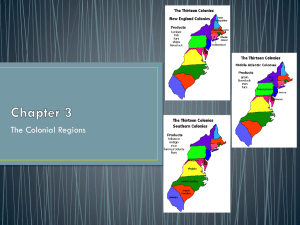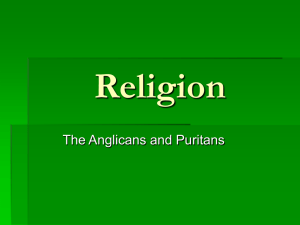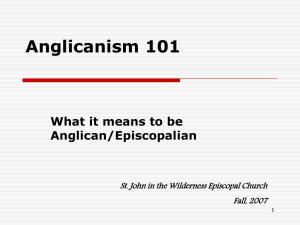Religious Movements
advertisement
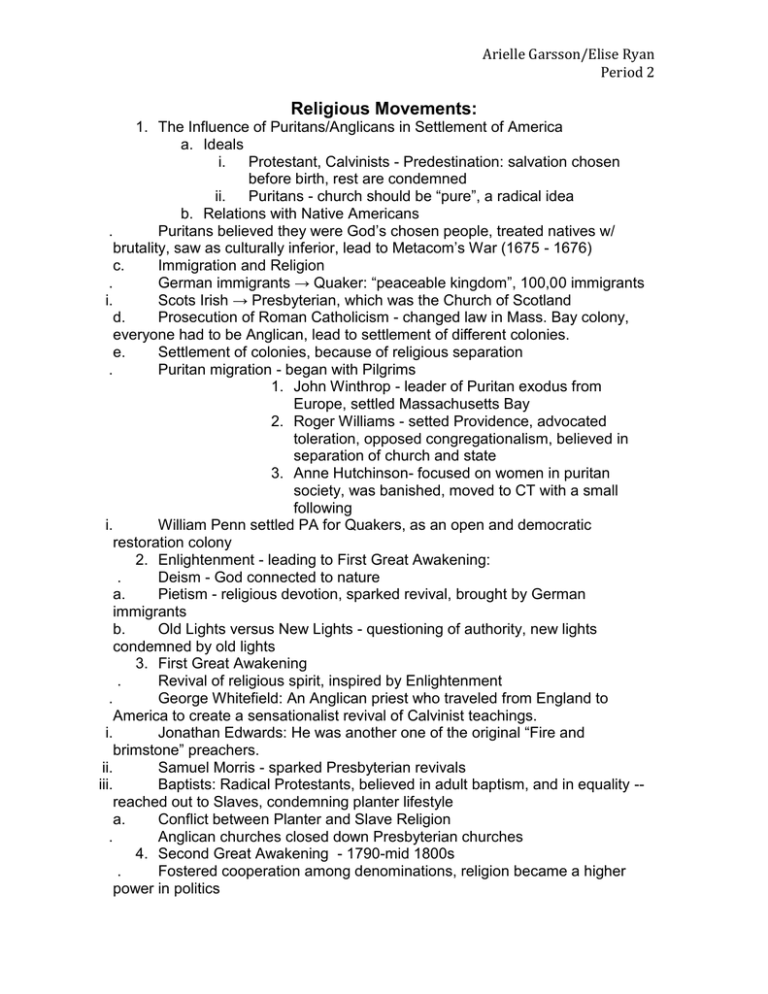
Arielle Garsson/Elise Ryan Period 2 Religious Movements: 1. The Influence of Puritans/Anglicans in Settlement of America a. Ideals i. Protestant, Calvinists - Predestination: salvation chosen before birth, rest are condemned ii. Puritans - church should be “pure”, a radical idea b. Relations with Native Americans . Puritans believed they were God’s chosen people, treated natives w/ brutality, saw as culturally inferior, lead to Metacom’s War (1675 - 1676) c. Immigration and Religion . German immigrants → Quaker: “peaceable kingdom”, 100,00 immigrants i. Scots Irish → Presbyterian, which was the Church of Scotland d. Prosecution of Roman Catholicism - changed law in Mass. Bay colony, everyone had to be Anglican, lead to settlement of different colonies. e. Settlement of colonies, because of religious separation . Puritan migration - began with Pilgrims 1. John Winthrop - leader of Puritan exodus from Europe, settled Massachusetts Bay 2. Roger Williams - setted Providence, advocated toleration, opposed congregationalism, believed in separation of church and state 3. Anne Hutchinson- focused on women in puritan society, was banished, moved to CT with a small following i. William Penn settled PA for Quakers, as an open and democratic restoration colony 2. Enlightenment - leading to First Great Awakening: . Deism - God connected to nature a. Pietism - religious devotion, sparked revival, brought by German immigrants b. Old Lights versus New Lights - questioning of authority, new lights condemned by old lights 3. First Great Awakening . Revival of religious spirit, inspired by Enlightenment . George Whitefield: An Anglican priest who traveled from England to America to create a sensationalist revival of Calvinist teachings. i. Jonathan Edwards: He was another one of the original “Fire and brimstone” preachers. ii. Samuel Morris - sparked Presbyterian revivals iii. Baptists: Radical Protestants, believed in adult baptism, and in equality -reached out to Slaves, condemning planter lifestyle a. Conflict between Planter and Slave Religion . Anglican churches closed down Presbyterian churches 4. Second Great Awakening - 1790-mid 1800s . Fostered cooperation among denominations, religion became a higher power in politics Arielle Garsson/Elise Ryan Period 2 a. Religious revivals - Protestant Christianity spread Changing lives of women and blacks - changing sense of authority 1. Black Christian church - baptist and methodist 2. Evangelical church - new roles for women b. Split of Anglican/Protestant Church into multiple denominations c. Reform Movements . Benevolence/Good Works: Movement of missionary organizations, whose members were middle class to wealthy urbanites. Funded commitments to social change. i. Temperance movement: A movement against the excessive use of alcohol, with many of its members the wives of alcoholics. ii. Utopian Communities 1. Shaker Movement: A small denomination that practiced celibacy and equality for genders. Lived in New England. 2. Oneida Community: Practiced group marriage, child rearing, and group discipline to “improve” the genetic composition of their offspring. iii. Mormons: Founded by Joseph Smith as the Church of Latter-Day Saints who moved towards the Utah territory during Western expansion. Many practiced polygamy in their early stages, yet practiced abstention from sex before marriage. 1. Many against mormonism, due to polygamy iv. Abolitionists: Multiple groups consisting of former slaves and Northern politicians that were against the practice of slavery in the South. Leaders included Frederick Douglass, William Lloyd Garrison. Rallied for new states to not include the right to slavery. d. Women’s Rights - women were a majority of converts, learned new independence, found new roles in congregations. 5. Religion and Western Expansion . “Manifest Destiny” . 1840s - citizens embraced the ideology of conquest, believed in a “God given duty” to extend America to Pacific a. Changing religious norms b. Native American assimilation . Christian Reformers - in charge 1. argued that native peoples had the innate capacity to become equal with whites, could achieve only if they were christianized and educated in White ways 2. aimed to destroy native languages, cultures, and religions, while they ignored dissenters, who said it was a white problem not an indian problem .
